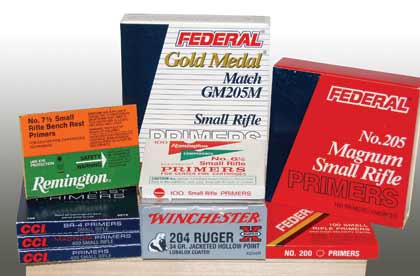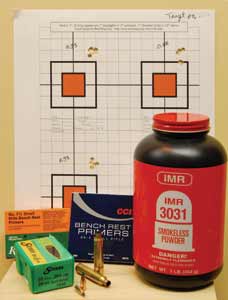January 04, 2011
By Lane Pearce
Practical Reloading
By Lane Pearce
 Lane substituted different Small Rifle primers in a proven .204 Ruger handload to try to achieve reduced standard deviation and better accuracy. |
Conventional wisdom--and just about every reloading scribe I've read recently--suggests that employing consistent and uniform components and reloading processes usually results in top-performance ammunition. That's why handloaders segregate cases by brand and, when possible, by lot; prep the primer pockets and flash holes; trim them to the same length and chamfer the case mouths; seat the same brand and lot of primer carefully just below flush; and weigh each powder charge. They sometimes go as far as segregating the cases and bullets in like batches by weight before seating the bullets to the same exact overall length.
That might sound tedious, but routinely performing these steps helps ensure that the internal ballistics--primer/propellant ignition and deflagration--are as uniform as possible so the subsequent external ballistics--i.e., muzzle velocity and trajectory--may also be similarly uniform. Specifically, handloaders who chronograph their loads often equate obtaining consistent velocities with the likelihood of achieving smaller groups.
Advertisement
So what is the norm for consistent velocities? I've concluded from reading several sources that the Standard Deviation (SD) should be about 20, and half of that is even "more better!" In addition, other reloading authors have recommended switching primers to possibly achieve more consistent velocities and, hence, better accuracy.
In previous columns, I've related that my loading and shooting experience hasn't always supported this oft-repeated tenet. In fact, while preparing a handloading article on the .204 Ruger for a recent Hodgdon's Annual Reloading Manual, I achieved excellent accuracy with handloads that significantly exceeded the SD norms noted above. I revisited my findings in that report and decided to run an experiment to see if it substantiated or refuted the conventional wisdom and if I could reduce SD by substituting primers.
The load I selected delivered the best accuracy in the previous shooting review. It also exhibited rather large velocity variations, i.e., for 20 rounds, the extreme spread and SD values were 136 and 34, respectively. As you may know, the relative confidence one has in statistical results depends on two factors: how many data points and how precise they are. Calculating SD based on at least 20 velocity measurements is generally accepted as just barely good enough.
Advertisement
Because I'm an engineer first and a handloader somewhere after, I knew I must retest the reference load using the same components and rifle to assure any subsequent assessment or conclusions would be valid.
I retrieved the original data sheet for that specific handload and rounded up the same container of IMR-3031 powder, several more boxes of once-fired Winchester brass, an unopened box and a partial box of Sierra 39-grain BlitzKing bullets, and a pack of the same lot of WSR primers. Then I assembled another box of the reference test load. Of course, the same Ruger Model 77 MKII Target rifle was still on my gun rack, cleaned and ready for action.
I set up my Oehler Model 35P chronograph the same way I always do when testing small-caliber ammo with the three skyscreens spaced 2 feet apart and the first sensor about 6 feet from the muzzle. After running a couple of clean patches through the rifle's bore to remove any oil residue, I fired a couple of fouling shots before shooting the new batch of handloads.
 Remington 7 1/2 and CCI BR4 primers delivered the most consistent and accurate groups even though the standard deviation for both loads was greater than the original reference load. |
When I completed four, five-shot groups, I hit the summary button and perused the results. I'd already studied the target downrange through the scope and was generally satisfied with the load's accuracy, especially the last one that resembled a little bug just above and to the right of the point of aim. The average velocity was 2 feet per second slower than before. Extreme spread was similar in the lower 100s, and SD was exactly the same value at 34 fps. I pulled the target and measured each group. The groups averaged out at 0.56 inch, which was essentially the same accuracy the original test load had delivered.
Needless to say, I was pleased with the results. I had re-established the standard to which I intended to compare the additional test loads using the same components but with different primers.
I retrieved eight more boxes of once-fired .204 Ruger cases from my stash and full-length sized, trimmed, and deburred each case before cleaning and uniforming the primer pockets. I did not debur the flash holes since I hadn't done so before.
Just to make sure I didn't get the test loads mixed up, I seated 20 primers of each brand/type in a batch of brass, dispensed the prescribed amount of powder, and seated the bullets to precisely the same position using an RCBS micrometer seating die. I labeled the completed box and repeated the procedure until I had assembled nearly 150 test loads. I had intended to load a box with Federal 200 primers, but when I opened the only pack I had, there were only five left. I figured that's enough for one group and loaded 'em up!
The Shooting Results
While November and December are not the best months for good range conditions in my corner of the world, I was fortunate in picking three nice days to shoot and gather data. Before firing each box of handloads, I cleaned the rifle thoroughly and then fired two Remington factory loads to foul the barrel and verify my chronograph was working properly.
Overall, I was pleased with most of the shooting, but as one might expect, my technique was not always consistent during all three range sessions. I'm sure an occasional group was adversely influenced by the ever-present human factor. In all, I "called" only two rounds, which I disregarded from the accuracy results.
After I finished shooting the various test loads, I assembled and fired another box of the reference load using new lots of powder and bullets but the same WSR primers. As you can see in the chart, I didn't do quite as well with these, but, coincidentally, my last group measured spot-on at 0.55 inch. The SD was lower but still well over 20.
Observations
You know what they say about sta
tistics. You can usually take the same data and "prove" quite different conclusions. As best as I can tell, such is the case with my results. The one thing I clearly believe from the numbers is that you can shoot good groups consistently even when SD exceeds 20.
EFFECTS OF SWITCHING PRIMERS |
| GROUP SIZE (in.) | VELOCITY (fps.) |
| PRIMER BAND | PRIMER TYPE | 1st | 2nd | 3rd | 4th | AVE. | AVE. | ES | SD |
| .204 RUGER |
| WSR * | Standard | 0.80 | 0.53 | 0.62 | 0.28 | 0.56 | 3631 | 136 | 34 |
| Fed. 205 | Magnum | 0.28 | 0.70 | 1.15 | 0.68 | 0.70 | 3563 | 92 | 22 |
| Rem. 7 1/2 | Match | 0.35 | 0.35 | 0.55 | 0.65 | 0.48 | 3651 | 151 | 38 |
| CCI BR4 | Match | 0.38 | 0.65 | 0.55 | 0.38 | 0.49 | 3673 | 118 | 37 |
| CCI 400 | Standard | 0.75 | 1.12 | 1.05 | 0.85 | 0.94 | 3648 | 168 | 46 |
| Fed. GM205 | Match | 0.75 | 0.72 | 0.80 | 1.00 | 0.82 | 3565 | 67 | 21 |
| CCI 450 | Magnum | 0.55 | 0.55 | 0.75 | 0.60 | 0.61 | 3612 | 138 | 34 |
| Rem. 6 1/2 | Standard | 1.05 | 0.75 | 0.65 | 0.90 | 0.84 | 3659 | 130 | 41 |
| Fed. 200 ** | Standard | 0.70 | n/a | n/a | n/a | 0.70 | 3612 | 20 | 6 |
| WSR *** | Standrd | 0.65 | 0.80 | 1.00 | 0.55 | 0.75 | 3613 | 97 | 27 |
* .204 Ruger reference load of 25.3 grains IMR-3031, Sierra 39-grain BlitzKing bullet, Winchester brass.
** Only had five primers available.
*** Repeated reference load with new lots of powder and bullets but with same primers. |
Handloads with Remington 71/2 and CCI BR4 match primers delivered a bit better accuracy compared to the groups achieved with the WSR-primed reference load. However, the SD values for these two handloads were significantly greater than the results for the reference load.
I called my ballistics mentor, Dr. Ken Oehler, to see if he could shed any technical insight on this situation. When I related that the new reference batch of handloads yielded essentially the same results as before, he promptly responded, "You were just lucky!"
"Twenty rounds are generally accepted as the minimum amount of data required for statistical analyses," he continued. "However, you'd probably wear out several barrels to get a truly adequate data population to draw any valid conclusions for the experiment you're attempting. For limited data like you have, the SD values can only be used as an indicator of potential performance, like shooting a few three-shot groups to see if a specific load is repeating in further testing."
From a practical standpoint, I believe I've just reaffirmed the lessons learned from shooting thousands of rounds over the chronograph. The "real" results are how well your handloads perform after the bullets exit the barrel, i.e., how they group.
As we engineers say, "...the rest is simply cross-plotting data...."

